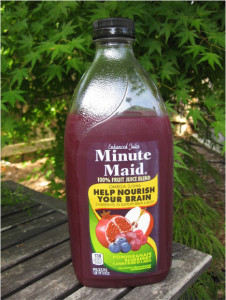 By Leslie Francis for BiolawToday.org.
By Leslie Francis for BiolawToday.org.
On October 20th, the Center for Law & Biomedical Sciences was delighted to host a talk by C. Randolph (Randy) Ross, on “When a Pharmaceutical Patent is Not Enough.” Co-sponsored by the law firm of Maschoff Brennan Laycock Gilmore Israelsen & Wright, the talk was a tour through various kinds of litigation concerning prescription products but not involving patent rights. Mr. Ross, recently retired from his position as litigation counsel at Breckenridge Pharmaceutical, has a wealth of experience especially from the perspective of manufacturers of generic pharmaceuticals. Mr. Ross has kindly shared with us brief descriptions and links to the cases that he discussed. We are grateful to him for his very informative presentation and for following up with these materials.
 Many disputes in this area involve labeling. In Pom Wonderful LLC v. The Coca-Cola Company, 134 S.Ct. 2228 (2014), the US Supreme Court held that a claim for false or misleading representation under §43(a) of the Lanham Act is not precluded simply by the fact such representation is on a label regulated by the FDA. Pom Wonderful, maker of fresh pomegranate juice, claimed that this label for Minute Maid’s juice that included a small amount of pomegranate juice and blueberry juice would mislead consumers. Note that the large print says “Pomegranate Blueberry,” which the Supreme Court observed represent only 0.3% and 0.2% of the total contents:
Many disputes in this area involve labeling. In Pom Wonderful LLC v. The Coca-Cola Company, 134 S.Ct. 2228 (2014), the US Supreme Court held that a claim for false or misleading representation under §43(a) of the Lanham Act is not precluded simply by the fact such representation is on a label regulated by the FDA. Pom Wonderful, maker of fresh pomegranate juice, claimed that this label for Minute Maid’s juice that included a small amount of pomegranate juice and blueberry juice would mislead consumers. Note that the large print says “Pomegranate Blueberry,” which the Supreme Court observed represent only 0.3% and 0.2% of the total contents:
In Utah, in Catheter Connections, Inc. v. Ivera Medical Corp., No. 2:14-cv-70-TC (D. Utah July 17, 2014) is a decision involving “medical device” law, and illustrating the difference between Lanham Act claims that are and are not precluded by the federal Food, Drug & Cosmetic Act. Catheter Connections and Ivera were competitors in the market for disinfectant caps incorporated into intravenous lines. In addition to its claims that Ivera had infringed its patents, Catheter also claimed that Ivera had engaged in false advertising under the Lanham Act. The test employed by the court for preclusion was whether the determination that Ivera’s representation was true or false required interpretation of FDA regulations (which only the FDA can enforce), or whether the truth or falsity could be determined by a factual inquiry separate from interpretation of FDA regulations.
In SmithKline Beecham Consumer Healthcare L.P. v. Watson Pharmaceuticals, Inc., 211 F.3d 21 (2d Cir. 2000), the Second Circuit determined that a brand company cannot enforce a copyright over an FDA-mandated label. (Generic prescription products are required to use labels which are virtually identical to the brand’s label.)
Schering-Plough Healthcare Products, Inc. v. Schwarz Pharma, Inc., 586 F.3d 500 (7th Cir. 2009) is the Seventh Circuit decision deferring to the FDA on Schering-Plough’s claim that “Rx only” on the prescription generic products was false and misleading. Schering-Plough manufactured MiraLax, an over the counter laxative, and claimed that the labels on similar generics available by “prescription only” were misleading and literally false.
The following are from two cases (three decisions) related to Lanham Act claims based on the differences between L-5-methyltetrahydrofolate and D,L-5-methyltetrahydrofolate. The opinion in the Brookstone case explains the role of the pharmaceutical databases and “linking”.
Merck Eprova AG v. Brookstone Pharmaceuticals, LLC, 920 F. Supp. 2d 404 (N.Y.S.D. 2013)
Merck Eprova AG v. Gnosis S.P.A., 901 F. Supp. 2d 436 (N.Y.S.D. 2012)
Merck Eprova AG v. Gnosis S.P.A., 760 F.3d 247 (2d Cir. 2014)
There are also two recent important cases related to other aspects of pharmaceutical labeling, involving “product liability” lawsuits. In Wyeth v. Levine, 555 U.S. 555, 129 S.Ct. 1187 (2009), the Supreme Court held that a brand company may be liable for “failure to warn” if it becomes aware of dangers related to its product and does not update the warnings on its labeling. Pliva, Inc. v. Mensing, 131 S.Ct. 2567 (2011) held that this does not apply to generic pharmaceutical companies because they cannot change their labels without prior FDA approval.
Critical statutory and regulatory materials referenced in the cases include:
DRUG: From 21 CFR 314.3:
“Drug substance means an active ingredient that is intended to furnish pharmacological activity or other direct effect in the diagnosis, cure, mitigation, treatment, or prevention of disease or to affect the structure or any function of the human body, but does not include intermediates use in the synthesis of such ingredient.”
15 U.S.C. § 1125(a) (Section 43(a) of the Lanham Act):
“(a) Civil action
(1) Any person who, on or in connection with any goods or services, or any container for goods, uses in commerce any word, term, name, symbol, or device, or any combination thereof, or any false designation of origin, false or misleading description of fact, or false or misleading representation of fact, which—
(A) is likely to cause confusion, or to cause mistake, or to deceive as to the affiliation, connection, or association of such person with another person, or as to the origin, sponsorship, or approval of his or her goods, services, or commercial activities by another person, or
(B) in commercial advertising or promotion, misrepresents the nature, characteristics, qualities, or geographic origin of his or her or another person’s goods, services, or commercial activities,
shall be liable in a civil action by any person who believes that he or she is or is likely to be damaged by such act.”
